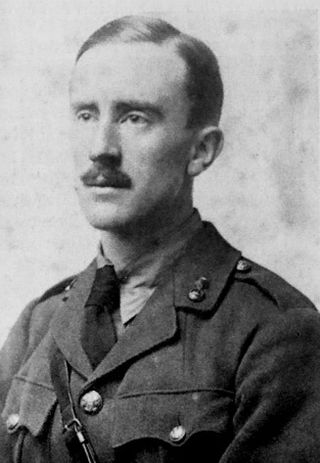Relationships
The Lord of the Wedding Ring: J.R.R. Tolkien’s True Love
Tolkien’s writings were inspired by his own passion and commitment to his wife.
Posted June 5, 2017
And he took her in his arms and kissed her under the sunlit sky,
and he cared not that they stood high upon the walls in the sight of many.
― J.R.R. Tolkien, Return of the King
John Ronald Reuel Tolkien is known worldwide for his fantastic characters and creations. His hobbits, dwarves, and warriors have changed the face of literature and culture. As a boy, he had unusual interests. He loved reading mythology, playing chess, drawing fierce dragons, and by age 9, young Ronald (as he was usually called) had invented several languages. Well-known is Tolkien’s prodigious geek cred, but less known is that he was a hopeless romantic. His new book, Beren and Luthien is coming out decades after the author’s death, but it tells a tale close to his heart. It is a story of love and sacrifice, and was inspired by his own passion for his wife, Edith.

Tolkien grew up in England in the early 1900s in difficult circumstances, having lost both his father and mother by his mid-teens. Taken under the guardianship of Father Francis, a Catholic priest, young Ronald became lonely and contemplative. At 16, he and his brother moved into a small apartment, where downstairs was a girl that would change Ronald’s life. Edith Bratt was a pretty nineteen-year-old, with light grey eyes and a flair for music. Ronald was lovestruck. Edith’s interest was piqued, and she began to befriend the Tolkien brothers. Ronald would lower a basket from his window, and Edith would load it with snacks. The food depletions must have puzzled Edith’s guardian, Mrs. Faulkner, as Edith was slender and less than five feet tall.
Over time, Edith was won over by the younger Ronald, and they began spending their spare time together. They made each other laugh. One amusing pastime was to meet at a rooftop tea room in Birmingham and throw lumps of sugar into the hats of those walking below. When one bowl was empty, they moved to the next table. Their companionship was so consuming, it caused alarm in Father Francis and Mrs. Faulkner (assigned the code name, “The Old Lady” by the pair). The guardians thought the relationship improper and were upset that Ronald was not attending to his studies. To skirt this disapproval, Edith and Ronald invented a whistle call, which would summon the other to the window, where they could talk into the night.
One weekend, the two conspired for a meeting in the countryside. They rode and returned separately, but were spotted by a caretaker, who mentioned it to the cook back at the church. Around this same time, Ronald failed his Oxford entrance exams, and Father Francis put his foot down and insisted there be no more courting of Edith. The pair could not be kept apart, however, and they again planned a rendezvous. They plotted well, met secretly, and boarded a train for a getaway. The retreat was to another town where they shopped at a jewelry store, buying gifts for each other’s eighteenth and twenty-first birthdays. Unfortunately, their luck was again cursed, as an observer recognized them and word got back to Father Francis. This time, the priest was firm and unambiguous – Ronald was to have no contact with Edith until his twenty-first birthday.
Tolkien was depressed, but dutiful, and obeyed his guardian’s wishes. Over the next three years, he passed his college exams, and began life at Oxford, playing rugby and studying Gothic, Anglo-Saxon, and Welsh. He did not, however, forget about his Edith.
On the eve of his twenty-first birthday, he sat in bed watching his clock. The moment it struck midnight, he began a letter to Edith, pouring out his love, and proposing marriage. After a few anxious days he received a letter back, with the devastating news that she was engaged to a more suitable prospect, George Field. She was getting old (almost twenty-four!) and felt the urgency of time. She also had assumed their long separation had cooled Ronald’s fancies and that he had moved on.
Ronald jumped on the first train to Cheltenham, where Edith met him at the station. They walked out into the chilly countryside along the railway viaduct. He made an impassioned case that melted Edith’s heart. She agreed to ditch George, and throw her lot in with the college boy with the strange interests in Beowulf and linguistics.
Their marriage was filled with joy, laughter, and four children. One day, the lovers had an experience that lodged so deep in Ronald’s soul that it became a key story in his books. He and Edith were walking in the woods and came upon a clearing filled with flowering white hemlock. She began to dance in the sunshine and it took Ronald’s breath away. Recounting this story to his son many years later, Tolkien wrote: “In those days her hair was raven, her skin clear, her eyes brighter than you have seen them, and she could sing – and dance.” This event inspired the romance between Beren and Luthien, a mortal man and an elf-maiden. In his book, The Sillmarillion, he wrote of the pair: "But wandering in the summer in the woods of Neldoreth, Beren came upon Luthien, daughter of Thingol and Melian, at a time of evening under moonrise, as she danced upon the unfading grass in the glades beside Esgalduin. Then all memory of his pain departed from him, and he fell into an enchantment; for Luthien was the most beautiful of all the children of Iluvatar."
When Tolkien submitted his Lord of the Rings manuscripts to his publisher, they questioned his inclusion of any romantic elements. Specifically, he was told that the story of Aragorn and Arwen, which parallels Beren and Luthien, was "unnecessary and perfunctory.” The publisher didn’t think that a chest-pounding story of men and magic needed any mushy stuff. Tolkien pushed back, citing the stirring nature of love. In his letter to publisher Rayner Unwin, he plead the case for including the doomed lovers: “I still find it poignant: an allegory of naked hope. I hope you do.” His passionate heart again prevailed, and Tolkien kept the romance in the story.
Edith died in 1971 at age 82 in Bournemouth, Hampshire, England and Tolkien had the name “Luthien” engraved on her headstone. When he died twenty-one months later, he was buried with her, with the name “Beren” added to his name.

The passion between J.R.R. Tolkien and his beloved Edith is moving, because we all have passion within. Their fierce connection demonstrates the depth of love humans can attain. However, although relationships catch fire with passion, they continue burning through effort and sacrifice. Tolkien understood this, as he reflected about how his marriage took commitment to stay strong. He said, “Nearly all marriages, even happy ones, are mistakes in the sense that almost certainly … both partners might [have] found more suitable mates. But the real soul-mate is the one you are actually married to.” Despite Tolkien’s passionate nature, he understood that relationships take work: “No man, however truly he loved his betrothed and bride as a young man, has lived faithful to her as a wife in mind and body without deliberate conscious exercise of the will, without self-denial.”
Tolkien knew that true love isn’t attained by a flash of ecstatic desire. It takes regular care and attention to the little things. For example, Ronald and Edith loved fussing over each other and giving each other small presents. In their later years, they talked together endlessly about their children and grandchildren. Their relationship was built upon passion and friendship, which nourished their love from their early courtship until the end of their lives.
From Love Me True: Overcoming the Surprising Ways We Deceive in Relationships. Cedar Fort Publishing.
References
Humphrey Carpenter, Tolkien: The Authorized Biography (Houghton Mifflin, 1977).
Colin Duriez, JRR Tolkien: The Making of a Legend (Oxford, UK: Lion Books, 2012).
Carpenter, Humphrey and Tolkien, Christopher (eds.) (1981). The Letters of J. R. R. Tolkien (London: George Allen & Unwin).
Alison Flood, “JRR Tolkien Advised by WH Auden to Drop Romance,” The Guardian, 11 February 2014.
Sam Guzman, “Tolkien Speaks: The Secret to a Happy Marriage,” July 13, 2015. Retrieved from http://www.catholicgentleman.net/2015/07/tolkien-speaks-the-secret-to-a…
Judi Heit, “Edith Bratt Tolkein” 2010. Retrieved from http://classicmuses.blogspot.com/2010/06/edith-mary-bratt.html




